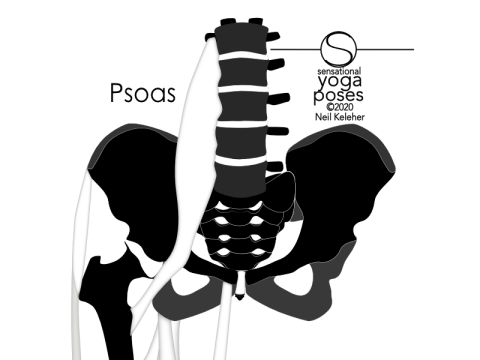Psoas Release
Stabilizing the hip joint to release the psoas
For effective psoas release, it's helpful to understand why the psoas is tense in the first place.
One reason for a contracted psoas is that the hips (and legs) are too relaxed.
If the legs are too relaxed, the psoas may engage to help create hip stability.
Activating the abs, particularly the external obliques (lengthen the neck, lift the front ribs, pull the top of the pelvis (iliac crests) rearwards) may help create a psoas release by creating a stable core but then this requires the external obliques to always be engaged, which seems "inelegant" and may lead to other problems down the road.
In my own experience, tensing the muscles of the legs or hips, particularly the gluteus maximus also isn't the answer. (Though if it works for you then definitely use it!)
Counter Nutation
In the mula bandha and sacroiliac joint articles I talk about how the pelvic floor muscles can be used to counter-nutate the sacrum, tilting it backwards relative to the pelvis.
My feeling and experience is that this action is good to use prior to psoas activation.
It helps to stabilize the spine which in turn gives the psoas a stable foundation from which to act on the thighs.
(I found this helpful when trying to lift or jump up into handstand.)
To facilitate this movement these same muscles pull the sitting bones inwards which in turn causes the iliac crests to spread outwards. The act of "counter-nutation" is more than just the sacrum tilting backards. It's also the bottom of the pelvis moving laterally inwards and the top of the pelvis moving laterally outwards. ("Laterally" means side to side.)
Nutation
In contrast, in my hip joint and muscles of the hip articles I talk about how the obturators (especially obturator internus) and the gemelli may help to spread the sitting bones when active which in turn causes the iliac crests (the hip bones) to move inwards. And I'm guessing tha this will be accompanied by a nutation of the sacrum which means it nods forwards relative to the pelvis.
Core Stability versus Hip Stability
Counter nutation may at times be a key action in creating core stability.
Meanwhile nutation and opening the hips may play a role in creating stable hips.
It may be that when standing it's desirable to have one but not the other. So if the hips are stable then the core doesn't need to be stable or strong. Nor does the psoas need to be contracted. The muscles of the core can then be used to move the upper body relative to the platform of the hips and pelvis.
If standing on one leg, then if that hip is stable then you might have the option of making the core stable so that you can kick or do something with the free leg, or you can relax the core if the other leg is also relaxed.
Creating Stable Hips to Help Cause A Psoas Release
For the following exercise, stand with your weight even on both legs, knees slightly bent.
Forward Tilt the Pelvis
If you have a chronically short psoas, the first step towards helping the psoas to release may be to let the pelvis tilt forwards while at the same time increasing the curve of the lower back. This will shorten the distance between the end points of the psoas. And if this is done without using the psoas to cause the action then this may actually take tension out of the psoas which may result in decrease of pain in the lower back (if you had it in the first place.)
This may or may not be enough to cause your psoas to release. However, walking around with a forwards pelvic tilt isn't ideal. The ideal is being able to control pelvic tilt without causing unnecessary tension in the psoas.
And so the next task is learning to control the muscles of the pelvic floor and hip joint.
Relax the Pelvic Floor Muscles
Relax the pelvic floor muscles so that the tail bone can move away form the pubic bone (sacrum tilts forwards relative to pelvis.)
Create Space in the Hip Joint
The next step is to activate the obturators and gemelli to help "lift" the pelvis off of the thigh bones. Think of pushing your knees away form your hip joints or do the opposite and push your pelvis up away from your knees.
Stand on One Leg, Level the Pelvis
To activate the side glutes and inner thighs, it might be easier if you stand with your weight on one leg.
Instead of letting your non weighted hip sink down, see if you can use your side glutes to level the pelvis. Keep your torso vertical (viewed from front.) And keep your pelvis tilted forwards. Once you can feel your side glutes activate, add more tension by "squeezing" the adductors of your weighted leg. But continue to keep your pelvis level.
Meanwhile, the non-weighted foot can just "rest" on the ground.
Tilt Your Pelvis Backwards Slowly
The next exercise is to keep tension in the hip muscles of the weighted leg and work at tilting your pelvis back while trying to keep the psoas release.
As you tilt your pelvis back and straighten your lumbar spine, if you notice tension coming back into the lower back, then stop and return to the start.
Tilt your pelvis backwards slowly. And then return, and then try this same exercise on the other leg.
Standing On Both Legs
Then try doing this with weight on both legs. So that your psoas stays relaxed when standing on both legs, try to keep the hip stable by using adductors, abductors and gemelli and obturators.
Remember:
- Tilt the pelvis forwards and curve the lumbar spine
- Relax the Pelvic Floor Muscles
- Activate Gemelli and Obturators
- Activate Side Glutes and Adductors
Published: 2020 08 03



